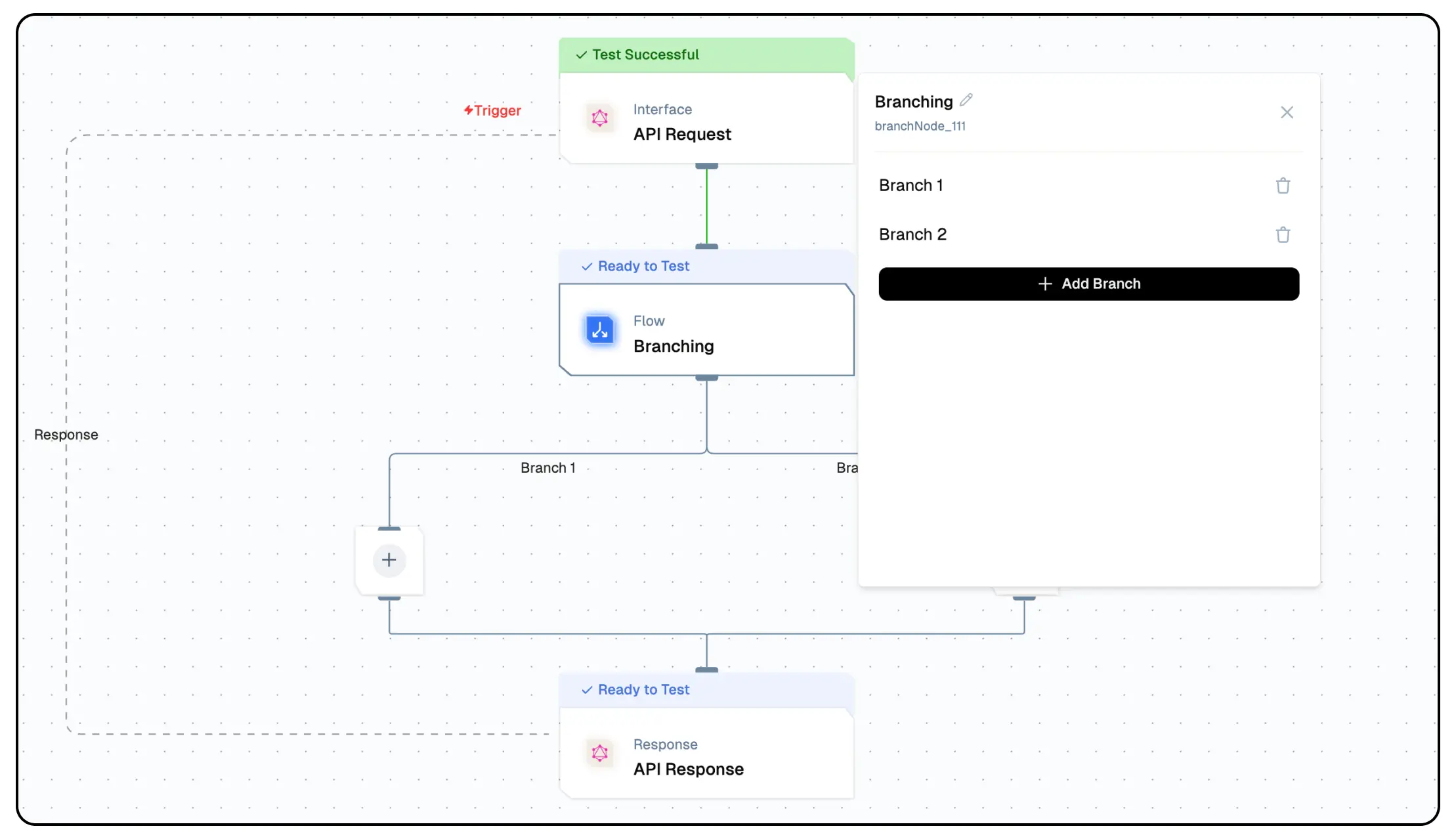Branch Node
Overview
The Branch Node is a workflow control component that creates multiple execution paths based on conditions or data routing logic. This node enables complex workflow branching and parallel processing of different data streams.

Node Type Information
| Type | Description | Status |
|---|---|---|
| Batch Trigger | Starts the flow on a schedule or batch event. Ideal for periodic data processing. | ❌ False |
| Event Trigger | Starts the flow based on external events (e.g., webhook, user interaction). | ❌ False |
| Action | Executes a task or logic as part of the flow (e.g., API call, transformation). | ✅ True |
This node is an **Action** node that creates multiple execution paths in workflows based on conditions and routing logic.
Features
Key Functionalities
-
Parallel Execution: Execute multiple tasks simultaneously, improving efficiency and reducing processing time.
-
Flexible Workflow Design: Easily create complex flow by adding, editing, or removing branches as needed.
-
Conditional Logic Support: Implement advanced logic to determine which branches to activate based on specific criteria.
-
Error Handling: Ensure robust flow with dedicated error-handling branches for different scenarios.
-
Real-time Monitoring: Track the execution of each branch in real time, providing visibility into the workflow's progress.
Benefits
-
Increased Productivity: Automate and parallelize tasks to reduce completion times and maximize output.
-
Enhanced Flexibility: Adapt flow to meet dynamic requirements with easy-to-configure branching structures.
-
Simplified Complexity: Manage intricate processes in a streamlined and visual manner.
-
Error Mitigation: Minimize risks by isolating and handling errors within specific branches.
-
Scalability: Build flow that grow with your needs, supporting additional branches or tasks as required.
What Can You Build?
- Multi-step Automation: Run several tasks in parallel, such as processing data, sending emails, and updating records, all within a single workflow.
- Simultaneous Integrations: Connect multiple tools or systems at the same time, ensuring efficient data synchronization and faster task execution.
Configuration
- Open the Branch Node Configuration Panel::
- Here you can manage branches.
- Define a respected node within each branch.
Note: Minimum two branches are required.
Low-Code Example
nodes:
- nodeId: branchNode_663
nodeType: branchNode
nodeName: Branching
values:
branches:
- label: Branch 1
value: branchNode_663-addNode_484
- label: Branch 2
value: branchNode_663-addNode_801
needs:
- triggerNode_1
branches:
- label: Branch 1
value: plus-node-addNode_484899
- label: Branch 2
value: plus-node-addNode_801189
- nodeId: plus-node-addNode_484899
nodeType: addNode
nodeName: ""
values: {}
needs:
- branchNode_663
- nodeId: plus-node-addNode_801189
nodeType: addNode
nodeName: ""
values: {}
needs:
- branchNode_663
- nodeId: plus-node-addNode_227323
nodeType: addNode
nodeName: ""
values: {}
needs:
- plus-node-addNode_484899
- plus-node-addNode_801189Output
input
- An object containing the data or parameters provided to the node for processing.
output
- An object representing the result or decision made by the branching logic.
skip
- A boolean indicating whether the branch condition resulted in skipping further processing or execution.
status
- A string denoting the operational status of the node, indicating success or failure of the branching process.
Example Output
{
"input": {},
"output": {
"skip": true
},
"status": "success"
}Troubleshooting
Common Issues
| Problem | Solution |
|---|---|
| Parallel Execution Errors | Verify that all branches are correctly configured and ensure no conflicts in dependencies. |
| Branch Activation Issues | Check conditional logic to ensure criteria are correctly defined. |
| Data Sync Delays | Ensure proper data mapping and synchronization across branches. |
| Error Handling Failures | Review error-handling logic and confirm fallback branches are set up correctly. |
Debugging Tips
- Verify branch and ensure all connections are correctly established.
- Inspect logs for branch-specific error details to identify the root cause of failures.
- Test individual branches independently before running the entire workflow.
- Confirm input data consistency across all branches to avoid unexpected outcomes.